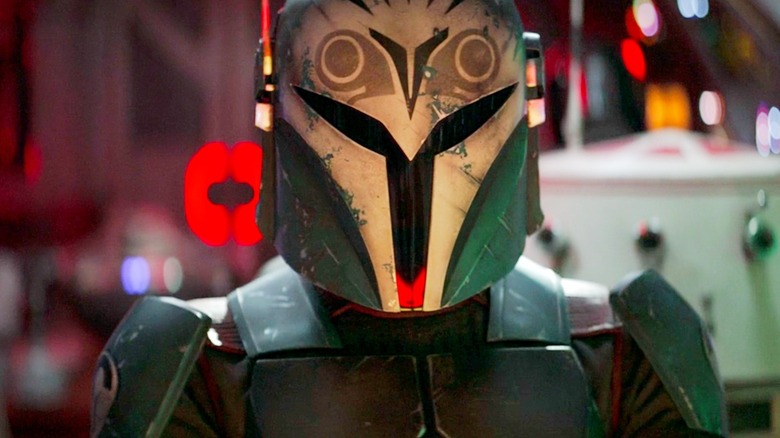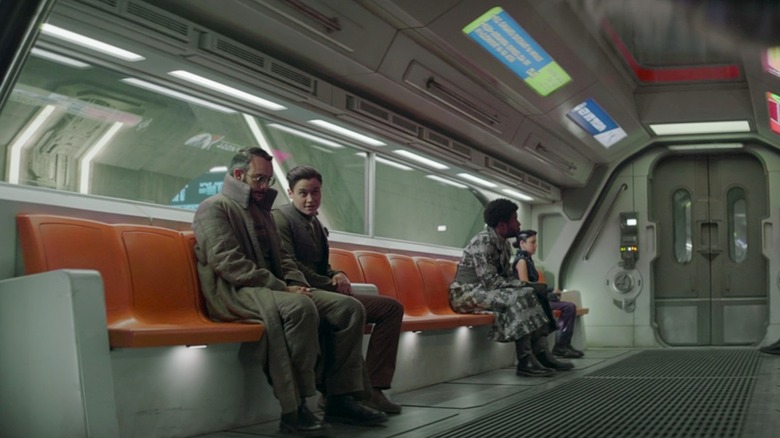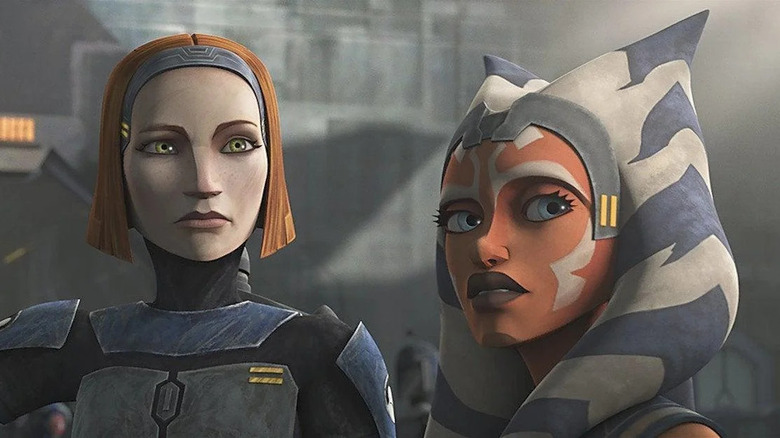The Mandalorian S3 Episode 3 Owes A Lot To The Clone Wars
With every passing "Star Wars" project, "The Clone Wars" becomes more essential to the current canon. And in "The Mandalorian" Season 3, that's especially true. Dave Filoni and the rest of the "Clone Wars" team effectively built the modern Mandalorian mythos, introducing key elements like Death Watch, the Darksaber, and the dome cities of Mandalore itself. Bo-Katan Kryze (Katee Sackhoff), now a major player in "The Mandalorian," also began her journey in "The Clone Wars."
All of those elements are central in Season 3, but Episode 3 — "The Convert" — is particularly evocative of "The Clone Wars." The meat of the episode follows Dr. Penn Pershing (Omid Abtahi), a former scientist for Moff Gideon's Imperial Remnant, as he acclimates to his new life on Coruscant. This might not seem as much like "The Clone Wars" as the parts featuring the actual Mandalorians, but "The Convert" owes much of its tone and structure to the precedent set by the animated series. Political intrigue on Coruscant is the name of the game in many "Clone Wars" episodes, and the earlier series frequently dedicated entire episodes to seemingly ancillary characters.
The Convert's political drama is classic Clone Wars
There are a few different kinds of "Clone Wars" episodes. You've got the classic war episodes, usually starring some combination of Anakin Skywalker, Obi-Wan Kenobi, Ahsoka Tano, and Captain Rex. Then you've got the more traditional cartoon episodes, where the younger characters learn lessons and go on adventures. And then, popping up a few times a season, you've got the political intrigue episodes.
"Clone Wars" episodes like "Senate Spy" and "Heroes on Both Sides" explore the snooty world of Coruscant politics, while more adventurous outings like "Lightsaber Lost" and "To Catch a Jedi" show the vast wealth disparity between the planet's upper crust and lower levels. All of these aspects are on display in "The Mandalorian" Season 3 Episode 3. There are even some hyper-specific "Clone Wars" details, like the police droids who patrol the ecumenopolis and the flying subway trains.
It's also worth noting that "Andor" brought these grittier Coruscant details to live action first, as it spends a lot of time at the ISB headquarters and various other government buildings. The office where Pershing works is very similar to the Imperial Bureau of Standards from "Andor," and given how haphazard the New Republic's transition seems to be, it could literally be the same building. It's interesting to see the planet explored in the New Republic era, though, and both shows owe a lot to the foundation laid by "The Clone Wars."
The Clone Wars is more important now than ever
As "The Mandalorian" gets deeper into the lore of its titular character and his people, "The Clone Wars" becomes more and more important for fans to watch. Unfortunately, there are plenty of current "Star Wars" lovers who've likely never seen the animated series all the way through. If you fall into that category, it's time to change your ways. Maybe you disregarded it at the time because you thought it was just a kids' show. Maybe you realize that's not the case now, but you've been so caught up in the Disney+ shows that you haven't had time to go back. Whatever the reason, it's time to watch, or even rewatch, because "The Clone Wars" isn't getting any less pivotal to the "Star Wars" story.
Even though "The Mandalorian" takes place nearly 30 years after the end of "The Clone Wars," it's still connected to it through direct storylines and episodes like "The Convert." "The Bad Batch" also keeps bringing back "Clone Wars" characters, and as long as Dave Filoni continues helming "Star Wars" projects, that isn't going to stop. Plenty of people will probably watch the upcoming "Ahsoka" show having only seen her in "The Mandalorian" Season 2, which is a shame. At this point, "The Clone Wars" should be required viewing.


